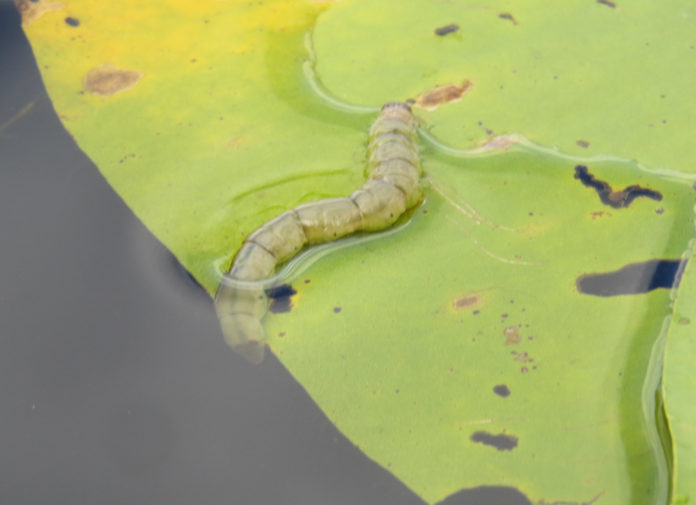Most people expect to find caterpillars in plants and trees or on the ground, but did you know some moth and butterfly larvae spend their time in aquatic habitats? Here’s a look at the lesser-known, water-dwelling contingent of order Lepidoptera. One such example is Bellura gortynoides, sometimes known as the white-tailed diver moth, a larva of which is shown here. (Photo via iNaturalist/mhalsted, CC BY-NC 4.0)
By Ed Ricciuti
A new-found wasp that hunts for caterpillars underwater, reported in November 2020 by scientists with an obvious eye for newsy names like Microgaster godzilla, amazed people worldwide, but news reports omitted an obvious question: What’s a caterpillar doing underwater in the first place?
In addition to the wasp, the caterpillar should have provoked a few “oohs” and “aahs,” at the least. Outside of entomologists, assorted moth and butterfly buffs, and fanatic fly-fishing purists, it’s a good bet that most people who read about the wasp had not known that several types of caterpillars—about 800 species in all—are aquatic. Maybe, however, the apparent indifference by the public and news media to the fact that some moths swim with the fishes is not all that surprising. Even entomologists have paid little attention to the curious band of moths that as caterpillars live in water.
Ed Ricciuti
“Aquatic and semi-aquatic moths are probably one of the most poorly studied ecological groups within the Lepidoptera,” writes Krzysztof Pabis, Ph.D., an entomologist at Poland’s University of Lodz, in a 2018 research paper in the journal Knowledge and Management of Aquatic Ecosystems. “The potential for various studies on their ecology and evolution is great and untapped.”
Aquatic moths “have fallen between the cracks,” says David L. Wagner, an entomologist at the University of Connecticut and author of the National Book Award-winning Caterpillars of Eastern North America. “There is very little biological data on these aquatic moths.” When it comes to the water, he says, “lepidopterists are out of their element,” while scientists such as aquatic ecologists often focus on insect groups that are a more dominant element of the water world, such as stoneflies (Plecoptera). Plus, the adults are completely nocturnal.
Eight hundred species might seem numerous, but not when compared to the total number of moth and butterfly (i.e., lepidopteran) species, which are estimated to number between 150,000 and a half million. And certainly not when one considers that more than 200,000 species in 16 of the 24 orders of insects live part or all of their life in water.
Actually, that so many insects depend on a watery habitat is not surprising, considering that research suggests that the class Insecta evolved from the same crustacean line that produced lobsters and shrimp. The evolutionary link of moths themselves to water is also evident in their close relationship to the aquatic caddisflies, or Trichoptera.
For most moths living in an aquatic environment, water is home for only the younger stages of life. Even then, not all are fully aquatic. Some species of Hyposmocoma caterpillars in Hawaii can live in or out of water. Other species live on wetland plants, but not actually under the water’s surface. Certain females with underdeveloped wings of another Hawaiian moth, Acentria ephemerella, are the only moths that are lifelong aquatics. Other females of the species, and all males, are landlubbers with fully developed wings.
Scientists often make a distinction between caterpillars that are aquatic, such as those that stay submerged, and others that live on aquatic plants above the water line. The semi-aquatic caterpillar of the Nymphula nitidulata, known as the beautiful china-mark, lives and feeds on the branched bur-reed (Sparganium erectum), a wetland plant. The aquatic Bellura melanopyga lives and feeds underwater on the yellow waterlily (Nymphaea americana). It breathes by surfacing to grab some oxygen, which it takes in through specialized spiracles leading to trachea, where it is apparently stored.
Periodic surfacing for air is one way that aquatic caterpillars obtain oxygen. Another is by using oxygen dissolved in water and breathing through hair-like gills, or through the skin. Some aquatic moth larvae trap a bubble of air within a tube of vegetation particles and debris that many species make as shelters. Air can also be trapped in hairs and similar structures covering the body.
Most truly aquatic caterpillars belong to a group known as snout moths because of the shape of their mouthparts. They constitute a single family, Crambidae, although some taxonomists do not make so neat a distinction, breaking down the classification into various subgroups. It matters not to the caterpillars.
Aquatic caterpillars stay almost entirely on their food plants or graze on algae-covered rocks and other objects. Some damage plants such as water lilies but also attack noxious invasives such as hydrilla.

The semi-aquatic caterpillar of the Nymphula nitidulata, known as the beautiful china-mark (adult shown here), lives and feeds on the branched bur-reed (Sparganium erectum), a wetland plant. The N. nitidulata caterpillar bores into plant stems during early stages, and then ensconces itself in a tube. (Photo via iNaturalist/snsergeevna, CC BY-NC 4.0)
You might expect that a critter that lives in water has body parts specialized for swimming, but aquatic caterpillars do not—and, in fact, they swim poorly and have legs generally similar to those that live on land. A few, however, swim with verve. The caterpillar of a moth of the American tropics, Paracles laboulbeni, moves through water with graceful undulations, looking for all the world like an artificial fly that is one of the most utilized by fly fishers, the “wooly bugger.”
Caterpillars living in streams fight the current by anchoring themselves with silky tents. Several species encase themselves with tubes of tiny pieces of plants and debris, much like caddisfly larvae. Nymphula nitidulata bores into plant stems during early stages, and then ensconces itself in a tube.
Aquatic caterpillars hatch from eggs laid by female adults in a variety of places below the surface: the undersides of floating vegetation, on stems, and on rocks, to name a few. Some deposit eggs by dipping their abdomen just below the surface. Others take the plunge and dive several feet down, placing eggs on rocks and breathing from a capsule of air captured above the surface. Most aquatic caterpillars undergo the pupal stage in the water; the aforementioned Paracles laboulbeni makes a cocoon of air-trapping body hairs and silk that floats on the water amidst the vegetation on which it has fed.
Introduced into North America from Europe, the life cycle of Nymphula nitidulata is fairly typical of aquatic moths. Females often lay from 100 to 300 eggs twice a year on host plants such as milfoil. The larval stage lasts about 42 weeks, with pupation and emergence in summer, when adults reproduce.
Whether emerging into adulthood or laying eggs, aquatic moths are up and about only in the dark of night, which is why so many anglers do not realize that trout relish them. Anglers who do know their value often use flies that represent caddisflies.
Scientists believe caddisflies and lepidopterans evolved from the same ancestor, perhaps more than 200 million years ago. Given that insects presumably evolved from crustaceans, which are primarily aquatic, moths that have aquatic larvae have, in effect, returned to their far distant origins.
Ed Ricciuti is a journalist, author, and naturalist who has been writing for more than a half century. His latest book is called Bears in the Backyard: Big Animals, Sprawling Suburbs, and the New Urban Jungle (Countryman Press, June 2014). His assignments have taken him around the world. He specializes in nature, science, conservation issues, and law enforcement. A former curator at the New York Zoological Society, and now at the Wildlife Conservation Society, he may be the only man ever bitten by a coatimundi on Manhattan’s 57th Street.
Related
Credit: Source link






























